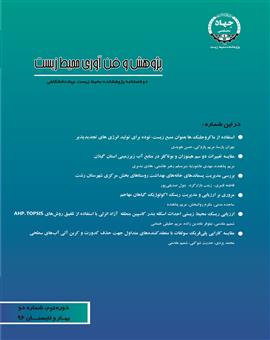مقایسه تغییرات دو سم هینوزان و بوتاکلر در منابع آب زیرزمینی استان گیلان
محورهای موضوعی : آلودگی منابع آبمریم پناهنده 1 , مهدی عاشورنیا 2 , میرمسلم رهبر هاشمی 3 , هادی مدبری 4
1 - پژوهشکده محیط زیست
2 - عضو هیات علمی
3 - عضو هیات علمی
4 - عضو هیات علمی
کلید واژه: هینوزانبوتاکلر کروماتوگرافی گازیآب,
چکیده مقاله :
این بررسی با هدف مقایسه محتوای دو سم پرکاربرد در استان گیلان برای افزایش محصولات کشاورزی به ویژه برنج در آب مصرفی ساکنان گیلان زمین در فصل بهار انجام گرفته است. بدین منظور 20 حلقه چاه در روستاهای گیلان برای بررسی انتخاب گردید. فرایند استخراج با روش مایع و با فاز N-هگزان- دی کلرومتان (1:1) برای بررسی مورد استفاده قرار گرفت. محصول استخراج جهت اندازه گیری به دستگاه کروماتوگرافی گازی با آشکارساز گیرانداز الکترون (GC-ECD) تزریق شد. فرایند نمونه برداری و اندازه گیری انجام شد. اندازهگیری کمی با روش استاندارد خارجی صورت پذیرفت. بررسیهای انجام شده موید این موضوع بودند که در فصل مورد بررسی مطالعه محتوای سموم هینوزان و بوتاکلر از حدود استاندارد و مجاز بیشتر نمی باشند ولی به دلیل قابلیت سمیت و اثر آنها در طولانی مدت بر موجودات مصرف کننده به ویژه انسان باید پایش مداوم از مقدار آنها در آب قابل مصرف ساکنین انجام گیرد.
The aim of this study was to compare the content of two commonly used poisons in Guilan province in order to increase the crops, especially rice, in water used by residents of Gilan in spring. For this purpose, 20 wells were selected in the villages of Guilan. The extraction process was carried out using liquid and N-hexane-dichloromethane (1: 1) phases for analysis. The extraction product was injected into a gas chromatograph with an electron capture detector (GC-ECD) for measurement. The sampling and measurement process was carried out. Quantitative measurements were carried out using external standard methods. The studies carried out confirmed that in the study chapter, the study of the content of Hinosan and Butachlor pesticides is not more than standard and more acceptable, but due to their toxicity and their long-term effects on creatures Consumers, especially humans, it be used continuous monitoring of their amount in water by residents.


